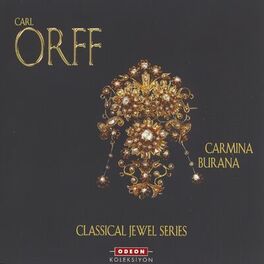


At a second-hand bookstore, Carl Orff encountered this image in a volume containing some of that manuscripts poetry, in translation, bearing the tawdry title Wine, Women, and Song. In one sense, it began with the page to the left: the first from an untitled 13th-century manuscript, featuring Fortune at her wheel. “Beuern” refers to the Benedictine monastery in Bavaria where, in 1803, a collection of thirteenth-century songs and poems was uncovered. That mouthful of a title reveals several things about Carmina’s origins and its composer’s intent. Carmina Burana: Cantiones profanæ cantoribus et choris cantandæ comitantibus instrumentis atque imaginibus magicis (“Songs of Beuern: Secular songs for singers and choruses to be sung together with instruments and magic images”) first came to life in Germany more than eighty years ago, in 1937. Baritone Dietrich Fischer-Dieskau brings the nuance of a Lieder artist to his solos, while tenor Gerhard Stolze, in spite of some liberties with phrasing, proves unerringly comical.A thunderous low D, the portentous crash of a gong, dozens of voices crying out, “O! Fortuna:” the unmistakable beginning of one of the most famous and popular choral-orchestral works of the twentieth century, Carl Orff’s cantata, Carmina Burana.

No one has ever done the Bavarian beer hall bit any better, and the whole performance is fun from start to finish. The orchestral playing sounds clean, characterful and suggestive the choral singing suitably lusty. German conductor Eugen Jochum's picturesque recording has a Germanness that is exactly on the mark. Orff's Carmina Burana invites the performer and listener alike to participate in the hedonistic enjoyment of rhythmically catchy and frequently repeated tunes, as well as equally simple forms, consonant harmony, powerful singing and colorful scoring marked by unstinting use of percussion. The score, completed in 1936, received its premiere in Frankfurt on June 8, 1937. He made use of some two dozen texts (though none of the melodies in the manuscript) to fashion one of the 20th century's most popular works for chorus and orchestra. In 1935, the German composer Carl Orff (1895-1982) encountered the collection and was immediately seized by the earthy, unbridled imagery of its material. To this day, the original manuscript remains the richest source of secular poetry by the goliards - itinerant scholars and monks active in Europe from the late 10th century to the early 1200s. Carmina Burana was the title of a collection of medieval Latin and German lyrics published in 1847, taken from a 13th century manuscript then in the possession of a Benedictine abbey near Munich.


 0 kommentar(er)
0 kommentar(er)
